If you’ve noticed a type of bright green caterpillar encroaching on your carefully-tended garden, you’ll want a tomato hornworm complete guide, and an answer to the question: are they dangerous to our gardens?
The tomato hornworm, which eventually matures into the five-spotted hawkmoth, is a pest that uses tomatoes as a host plant during their growth. A tomato hornworm can be dangerous to the garden due to their ability to defoliate the plants and damage the fruits.
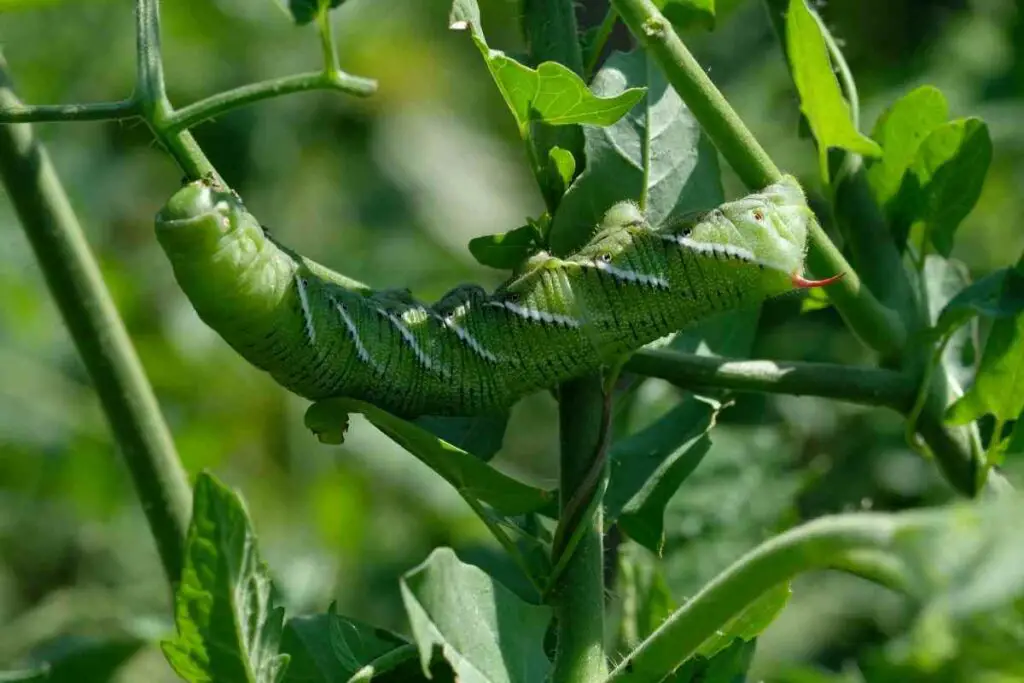
In this article, we’ll go over what a tomato hornworm is and how to identify it, the habits of tomato hornworms that make them dangerous to our gardens, the best way to repel them, and some frequently asked questions related to the topic!
Table of Contents
What Is a Tomato Hornworm?
One of the most important things when learning about a potential threat to your garden is knowing how to identify that potential threat!
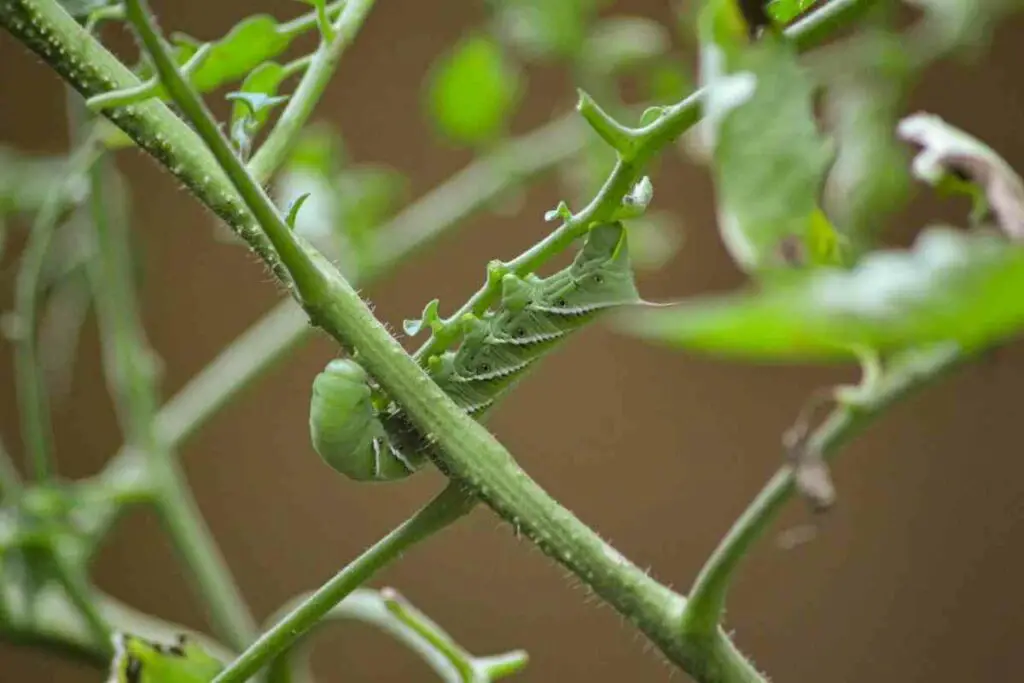
Below is a list of the characteristics of a tomato hornworm:
- Size – The size of a tomato hornworm is usually as large as ten centimeters or a little under 4 inches long. They are usually a little smaller in diameter than the common number 2 pencil.
- Color – Tomato hornworms are typically bright green, helping them to better blend in with their host plant, with around eight white markings similar to the letter “V” arranged in a pattern along their bodies.
- Horn – One of the reasons for the tomato hornworm’s name is it’s one intensely distinguishing feature: a red horn. This horn usually sprouts from the worm’s rear and is tipped slightly red, like the fruit of a tomato.
- Legs – The tomato hornworm will have around 12 little stump-like legs, allowing it to grip stems and move freely around it’s host plant.
On thing that may be important to note is that the tomato hornworm looks very similar to the tobacco hornworm.
A tobacco hornworm is not as vividly colored as a tomato hornworm, and although it sports the same distinct horn, it is usually missing the thick white markings.
However, equally important to acknowledge is the fact that both of these caterpillars will feed on the same types of plant.
What are the lifestyle and habits of a tomato hornworm?
Interestingly, a tomato hornworm is actually just the larva state of a moth called “M. quinquemaculata,” or the five-spotted hawkmoth.
Though they’re pretty enough as adults, the real trouble comes when they mature enough to lay eggs, as we’ll discuss below.
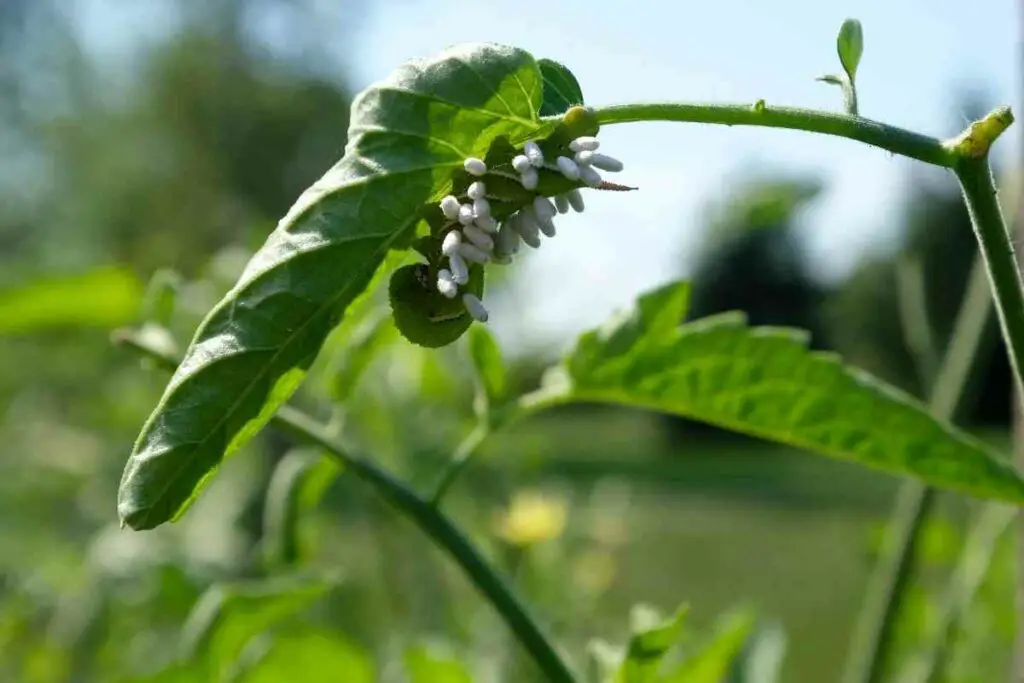
After hatching, the five-spotted hawkmoth begins life as a larva known as the tomato hornworm. It got this name from the rusty-colored horn protruding from it’s spine, as mentioned above.
The tomato hornworm is known to appear on plants with white flowers, meaning plants in the Solanaceae family, around the end of springtime.
They are only confined to eggs for one week after the female five-spotted hawkmoth oviposits them on the plant’s leaves.
This is because, while near the large leaves, the baby moths are petter protected from predatory birds and insects.
After Hatching – The larva grow and pupate over two to three weeks and mature into caterpillars capable of transforming into moths by early fall.
If born around the cold season, they spend the winter in the warm soil, close to the plant they were born near, before returning to the surface as adult moths in the spring.
Tomato hornworms don’t prefer feeding in full sunlight and will hide, inactive, until nightfall.
At dusk, or sometimes dawn, and often in the middle of the night, they will openly feed.
Now that you know what you need to look for, let’s move on to discussing how tomato hornworms behave and what danger they might pose to your garden.
Are Tomato Hornworms Dangerous To Our Gardens?
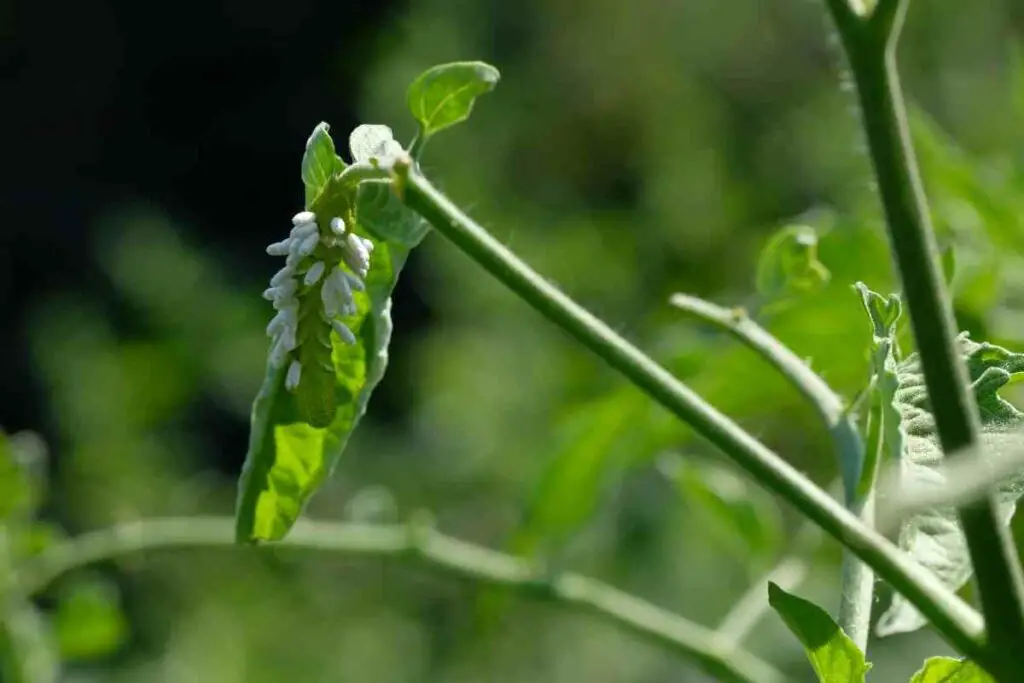
Nobody wants their hard work spoiled by creepy crawlies!
As brightly colored and, some might say, cute as tomato hornworms might look, they are indeed dangerous to gardens.
The ways that a tomato hornworm can effect a garden are listed below:
- Leaf Stripping
- Tomato Damaging
Let’s take a closer look at each of these problems which can cause a tomato plant to suffer or even die thanks to tomato hornworms.
Leaf Stripping
Leaf stripping refers to how much a tomato hornworm can defoliate a plant.
Defoliation simply means that the hornworm will damage and eat and remove leaves until your poor tomato plant is in very poor health!
Leaves are the primary way a plant photosynthesizes.
As you know, sunlight reaching these leaves is the main way a plant receives energy to survive.
However, tomato hornworms can eat more than three times their own weight in leaves.
This is especially dangerous because they continue to grow larger and larger throughout their lifespan.
When a tomato plant’s leaves are gone, it won’t be able to produce the tomato fruit.
If Left Unchecked – The leaf stripping process can lead to a plant’s degradation and eventual death.
Tomato Damaging
Not only is it unappetizing to find scars or markings on your tomatoes, but many tomato hornworms will actually begin feeding on tomato fruits while they are still green.
This renders the green tomatoes totally inedible by humans.
When Are Tomato Hornworms Dangerous?
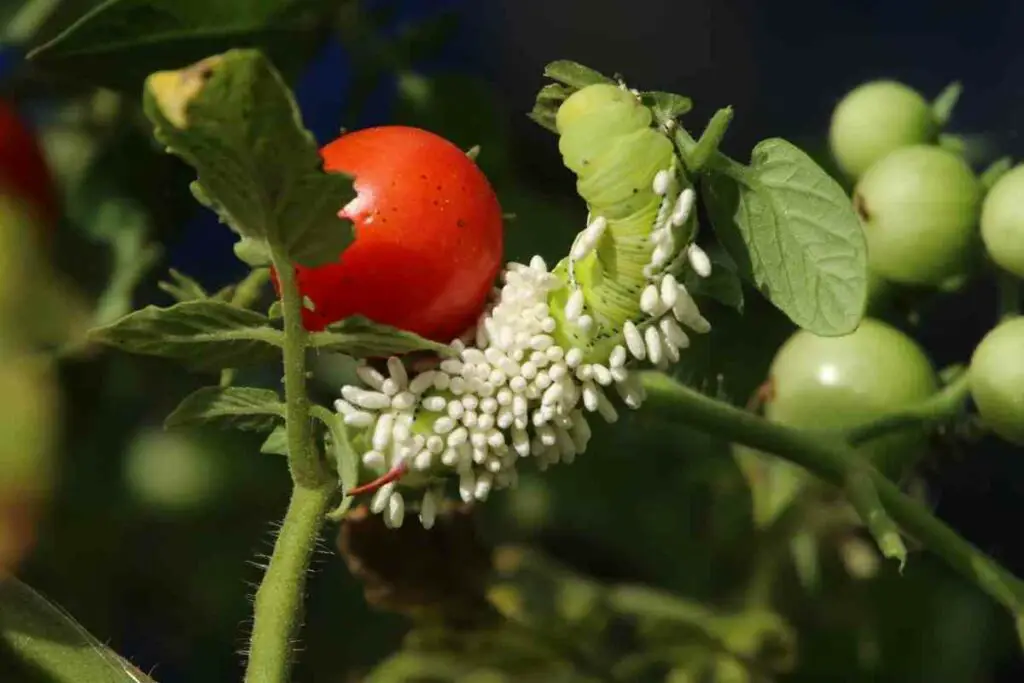
Tomato hornworms begin posing a threat to tomato plants in the late spring, when female five-spotted hawkmoths will search out a host plant to lay their eggs on.
From that time onward, the tomato plant is in danger of the tomato hornworm’s effects for a full year as the caterpillars mature.
Where are tomato hornworms found?
The tomato hornworm can be discovered in gardens and on plants throughout all of Australia and all of the continent of North America.
It is more common to find them in the northern states, but the southern states are sometimes plagued by tomato hornworms, too.
The good news is that there is usually only one tomato hornworm to be found per tomato plant.
However, if you have a garden full of tomato plants near one another, it is likely that the siblings of one hornworm have found a home for themselves in your garden, as well.
How Can I Protect My Garden From Tomato Hornworms?
It’s all well and good to understand which pest is threatening your garden and how, but the real question is, how can the damage be stopped?
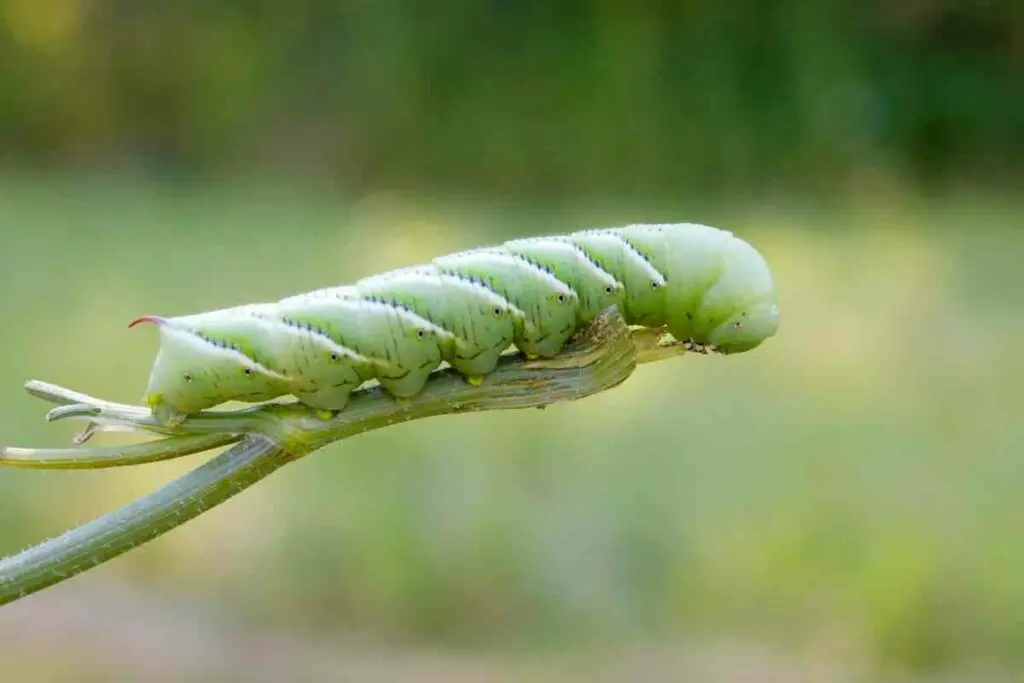
Below is a list of methods to use to protect your plants from tomato hornworms.
- Identify the signs of the tomato hornworm – The first step to any plan of attack is to know where your enemy is! The tomato hornworm may hide during the day, but you’ll know your plants are suffering when you start to spot the black droppings they leave behind or the scars on your tomato fruits.
- Remove eggs – The eggs of a tomato hornworm are usually shaped irregularly between a sphere to an oval. They don’t typically get larger than 1.5 millimeters, and range in color from light green to pure white.
- Remove weeds – A female five-spotted hawkmoth will not only look for tomato plants to lay her eggs near, but may also try laying eggs on weeds. Weeding is always a good idea to promote the health of your garden, but by getting rid of them promptly, you’re preventing hawkmoths from laying their eggs in the first place.
- Till soil – If you’ve noticed the telltale signs of a tomato hornworm on your plant, but haven’t spotted one yet, try tilling the soil around the base of the plant. Hornworms will often burrow there during the stages of their lives, not only to hide, but to pupate. You can find and dispose of them before they cause any more damage!
- Remove tomato horn worms from the plant – It might seem icky to have to touch tomato hornworms, but this is the best way to prevent them from causing damage! It is hard to do sometimes because their color matches the stems of most tomato plants. Do so at dusk or the early hours of the morning for the best chance of finding them.
- Kill the tomato horn worms – After plucking the hornworms off of your plant, you’ll want an efficient way to dispose of them. Dropping a tomato hornworm somewhere else outside allows for the slightest chance that they will simply return to the host plant. Instead, place them in water to kill them.
- Pesticides – Very few people enjoy having to put pesticides on their plants; especially a tomato plant! However, some pesticides, like Spinosad, are naturally occurring in some soils already and can kill off the younger stages of tomato hornworm. However, most pesticides for the hornworm only remain effective for two weeks and can harm bees.
- Insect Soap – Insect soap is another natural alternative to pesticides. It works best when caterpillars are smaller, and must be applied to the caterpillar’s body to work. Another benefit is that insect soap is made to keep beneficial bugs from getting hurt.
- Insecticides – Different from regular pesticides, insecticides last much longer than pesticides and can be applied to the plant a tomato hornworm is occupying only once before achieving great results. The only problem is, they do work against beneficial bugs, so be sure to factor in that risk.
- Introduce Ladybugs and Paper Wasps – Both ladybugs and paper wasps can be natural predators to the tomato hornworm. Ladybugs tend to eat the eggs and smallest forms of the caterpillars, while paper wasps love to feed on caterpillars of all sizes.
- Rely on Nature – It may not be a hands-on approach, but actually, the tomato hornworm can be gotten rid of by some natural occurrences in the wild. There are many types of parasites which will kill a tomato hornworm. If you spy something looking like rice coming from a tomato hornworm, it won’t trouble you much longer!
- Chase Away Moths – Any time you see a moth snooping around your garden, wave it away as often as possible! It could be a case of the five-spotted hawkmoth looking for a place to lay her eggs. Make sure she doesn’t have time to decide that your tomato plant is prime real estate!
These methods of stopping or getting rid of tomato hornworms are all effective.
It is up to you what kind of strategy your lifestyle and your gardening style will allow!
What Pesticides and Insecticides Can be Used on Tomato Hornworms?
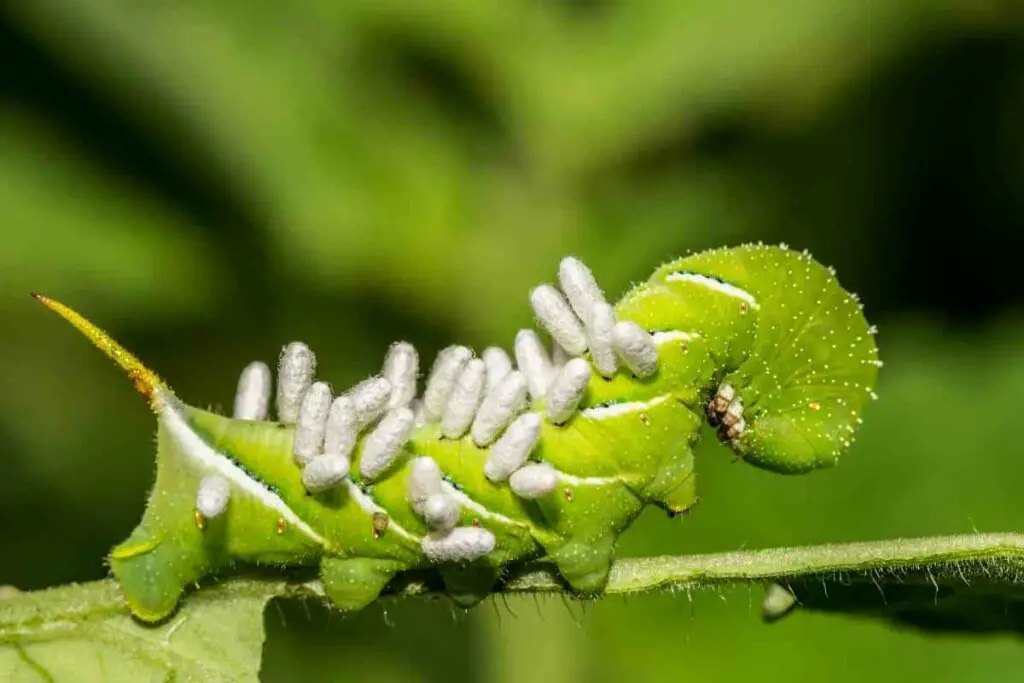
If you do decide to go the pesticide route when eliminating tomato hornworms from your garden, you may benefit from this list of effective pesticides:
- Carbaryl – This pesticide not only provides a detoxifying affect to plants, but it also dissipates pretty quickly. It is a cholinesterase inhibitor, meaning that it can get rid of tomato hornworms effectively. However, the United States Environmental Protection Agency has linked it to possibly causing cancer in humans, so use it sparingly!
- BT – BT, or bacillus thuringiensis has the added benefit of being organically based. It is, however, only effective against tomato hornworms that are on the smaller side. If your tomato hornworm pest is more than 5 centimeters or 2 inches long, BT likely won’t be effective enough to get rid of it.
- Spinosad – This is an anti-parasite insecticide which has also been used to treat head lice! It will do the trick against larval tomato hornworms, but only if the tomato hornworms are directly contacted by the spinosad.
- Bifen IT – Bifen IT can get rid of tomato hornworms if applied directly. However, the problem with Bifen IT is that it is not safe for the tomato fruit, or any of the surrounding vegetables in your garden that might prove to be edible. Use this insecticide with caution!
- Natia Oil Spray – Natia oil spray is an organic, versatile spray that can not only kill mature tomato hornworms, but can also eliminate green fruitworms and aphids. It can be sprayed on many plants of different varieties and works very quickly.
When considering pesticides or insecticides to fight off tomato hornworms, remember that you’ll need to make sure you aren’t ingesting a tomato after a toxic chemical has been applied.
Also worthwhile to remember is that not all animals are immune to the toxicity of some of these products, so keep your pets clear of the garden if they are in use!
What Are Some Frequently Asked Questions about Tomato Hornworms?
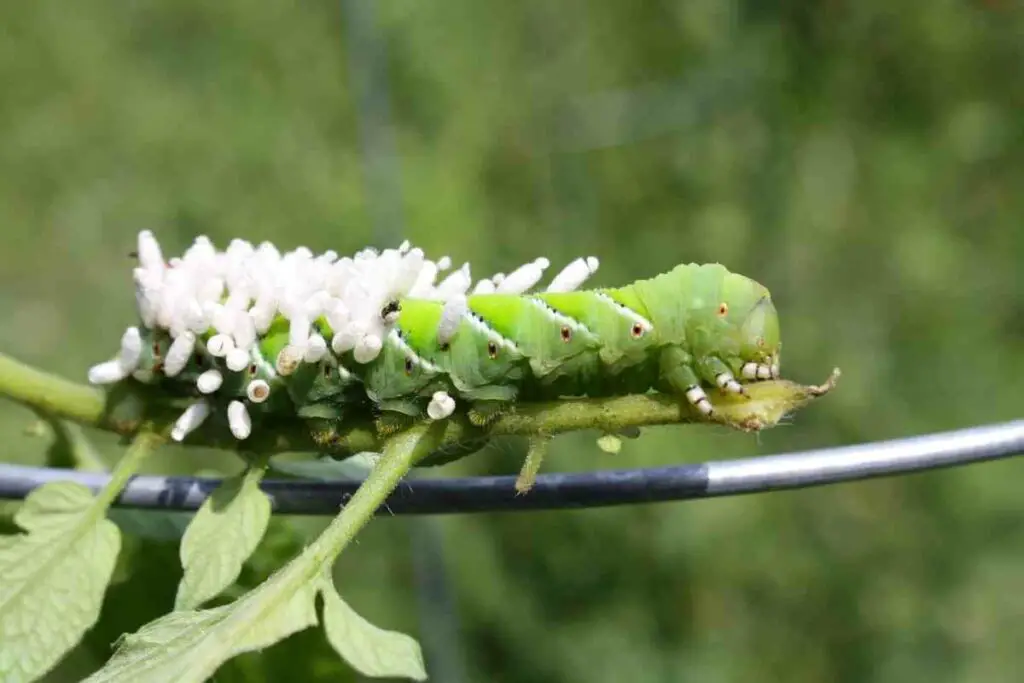
Below, you’ll not only find some of the most frequently asked questions about these pests, but the best answers to them, too!
Should I remove tomato hornworm?
If you notice dark droppings or caterpillar bite marks on your plants, and spy the tomato hornworm as the culprit, you should definitely remove the tomato hornworm!
This can be done using a pair of gardening gloves.
Once the hornworm is removed, drop it in a bucket of water to kill it. Otherwise, the hornworm can defoliate your plants.
Can tomato hornworms hurt you?
Tomato hornworms may look fierce with their small, sharp horn, but they have no ability to sting and their mouths are not large enough to bite you.
They are not a poisonous variety of caterpillar, and other than posing a threat to your garden, they have no ability to harm you.
What does a tomato hornworm turn into?
A tomato hornworm turns into a five-spotted hawkmoth.
The five-spotted hawkmoth is a tawny grey color with bright yellow markings and a fuzzy body.
Can you eat tomatoes that have hornworms?
It is not recommended that a human eat tomatoes which have had hornworms on them.
The hornworms themselves are not poisonous, but they can leave behind open scars on tomato fruits which allow entry by bacteria or parasites.
Are hornworms good for anything?
The only reason a tomato hornworm should be kept alive is because it is good for hosting a type of beneficial parasite called the braconid wasp.
The braconid wasp will resemble grains of rice attached to the hornworm’s body.
If you notice this on your tomato pest, don’t worry; the braconid wasp will kill the hornworm eventually and benefit your garden greatly.
Are tomato hornworms rare?
Tomato hornworms are not rare, and in fact, are very commonly seen throughout the months of late spring and summer all across America and Australia.
Will birds eat tomato hornworms?
Birds will eat tomato hornworms if they spot them.
Species of birds that will not only eat the worms themselves, but feed them to their babies, include the Baltimore orioles, the downy woodpecker, the bluebird, the sparrow, and the flycatcher.
How long does it take for a tomato hornworm to turn into a moth?
A tomato hornworm takes about a two to three weeks, from egg to pupate, to turn into a five-spotted hawkmoth.
Are hornworms poisonous to dogs?
The main reason hornworms are poisonous to dogs is that the plant matter they ingest, whether tobacco or tomato, can be toxic when eaten by a cat or dog.
Will tomato plants recover from hornworms?
Tomato plants can recover from hornworms as long as the hornworms are caught early enough.
If the defloration process has gone too far, a tomato plant may not be able to photosynthesize the energy it needs to keep growing, let alone produce fruit.
Conclusion
The tomato hornworm, which eventually matures into the five-spotted hawkmoth, is a pest that uses tomatoes as a host plant during their growth.
A tomato hornworm can be dangerous to the garden due to their ability to defoliate the plants and damage the fruits.
How to spot one?
Below is a list of the characteristics of a tomato hornworm:
- Size – The size of a tomato hornworm is usually as large as ten centimeters or a little under 4 inches long. They are usually a little smaller in diameter than the common number 2 pencil.
- Color – Tomato hornworms are typically bright green, helping them to better blend in with their host plant, with around eight white markings similar to the letter “V” arranged in a pattern along their bodies.
- Horn – One of the reasons for the tomato hornworm’s name is it’s one intensely distinguishing feature: a red horn. This horn usually sprouts from the worm’s rear and is tipped slightly red, like the fruit of a tomato.
- Legs – The tomato hornworm will have around 12 little stump-like legs, allowing it to grip stems and move freely around it’s host plant.
Check out the video above the find out more details.
- How to Dry Basil Leaves: A Professional Guide
- Is an Avocado a Fruit or Vegetable? Simple Answer and Explanation
- Does Pineapple Have Seeds? Exploring the Anatomy of Pineapples
- Blooming Through Winter: Can I Grow Vegetables Indoors in the Winter?
- What Can You Grow in a Greenhouse All Year Round: A Guide to Year-Round Greenhouse Gardening
- Are Blueberries Blue? Debunking the Myth of Their Color
















